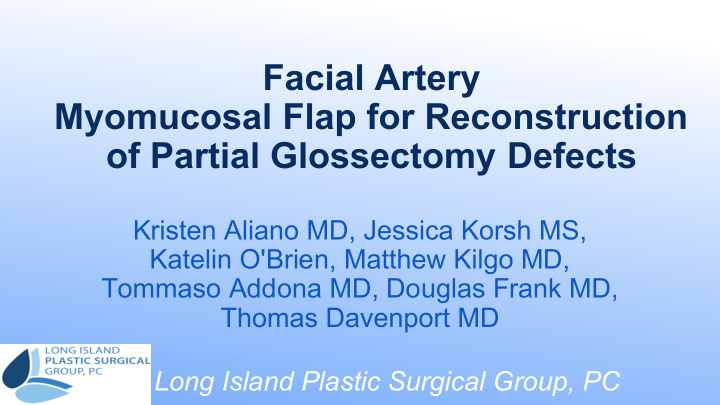



Facial Artery Myomucosal Flap for Reconstruction of Partial Glossectomy Defects Kristen Aliano MD, Jessica Korsh MS, Katelin O'Brien, Matthew Kilgo MD, Tommaso Addona MD, Douglas Frank MD, Thomas Davenport MD Long Island Plastic Surgical Group, PC
American Society of Plastic Surgeons 2014 Annual Meeting Nothing to Disclose
Objectives • To present research supporting the use of the FAMM flap for post-partial glosssectomy defects. • We propose the use of the FAMM flap for improved tongue function where the defect is too large for primary closure, but where free tissue transfer could interfere with tongue function.
Background • Reconstruction of partial glossectomy defects can be challenging because of a lack of local flap options Current Practice for Challenges Reconstruction Small Defects: Primary Can lead to constriction of the closure or STSG tongue Medium-Sized Defects: STSG RFFF can be bulky or RFFF
Background • The FAMM Flap reconstruction method was first introduced by Pribaz et al. in 1991 and used for the repair of intra-oral and intra-nasal defects • Versatility of FAMM Flap: • Superiorly based for mucosal defect closure of anterior hard palate, alveolus, nasal septum and upper lip. • Inferiorly based for posterior hard, soft palate, lower lip, and floor-of-mouth • Usually performed in a two-stage reconstruction with flap division in the 2 nd stage
Background FAMM Flap Illustrations
Methods 1. Tongue Defect 6. Healed Flap 5. Healed 2. Flap Donor Site Design 4. Flap 3. Flap Inset Harvest
Methods Retrospective chart review of 19 patients who underwent partial glossectomy with FAMM Flap reconstruction between 3/1/2009 and 7/1/2013 at North Shore-Long Island Jewish Outcome Measures •Flap Viability •Complications •Functional Outcome
Results Of the 19 Patients: • All flaps provided adequate coverage • No flap failures • 2 easily resolved complications • All had intelligible speech and adequate swallowing capabilities • 16 rated their voice quality to be good, very good, or excellent with no feeding interferences
Conclusions • The FAMM flap provides a good alternative to primary closure and split-thickness skin grafting post-partial glossectomy • The flap is close in proximity to the defect and is of similar tissue composition • The FAMM Flap produces a good functional outcome.
Significance of Findings The FAMM flap provides an excellent alternative to partial glossectomy defects that are less than 50% of the total surface area of the tongue.
References • Pribaz J, Stephens W, Crespo L, Grifford G. A new intraoral flap: facial artery Musculomucosal flap (FAMM) flap. Plastic and Reconstructive Surgery 1992; 90: 421- 429 • Duffy FJ Jr, Rossi RM, Pribaz JJ. Reconstruction of Wegener’s nasal deformity using bilateral facial artery Musculomucosal flaps. Plastic and Reconstructive Surgery 1998; 101: 1330-1333 • Dupoirieux L, Plane L, Gard C, Penneau M. Anatomical basis and results of the facial artery Musculomucosal flap for oral reconstruction. British Journal of Oral Maxillofacial Surgery 1999; 37: 25-28. • Fassio E, Laure B, Durand JL, et al. [The facial artery-buccinator Musculomucosal flap for reconstruction of the palate]. Rev Stomatol Chir Maxillofac 1999; 100: 221-225 • Pribaz JJ, Meara JG, Wright S, Smith JD, Stephens W, Breuing KH. Lip and vermillion reconstruction with the facial artery Musculomucosal flap. Plastic and Reconstructive Surgery 2000: 105: 864-872 • Hatoko M, Kuwahara M, Tanaka A, Yurugi S. Use of the facial artery Musculomucosal flap for closure of soft tissue defects of the mandibular vestibule. Int J Oral Maxillofacial Surg 2002; 31: 210-211
References • Heller JB, Gabbay JS, Trussler A, Heller MM, Bradley JP. Repair of large nasal septal perforations using facial artery Musculomucosal (FAMM) flap. Annals of Plastic Surgery 2005; 55: 456-459. • Joshi A, Rajendraprasad JS, Shetty K, Reconstruction of intraoral defects using facial artery Musculomucosal flap. British Journal of Plastic Surgery 2005; 58: 1061-1066 • Ashtiani AK, Enami SA, Rasti M. Closure of complicated palatal fistula with facial artery Musculomucosal flap. Plastic and Reconstructive Surgery 2005; 116: 381-386; duscission 387-388. • Ayad T, Kolb F, De Mones E, Mamelle G, Temam S. Reconstruction of Floor of Mouth Defects by the Facial Artery Musculomucosal Flap following cancer ablation. Head and Neck 2008; 30 (4): 437-445. • Hogikyan ND, WodchisWP, Terrell JE, Bradford CR, Esclamado RM. Voice-related quality of life (V-RQOL) following type I thyroplasty for unilateral vocal cord paralysis. J Voice 2000; 14(3): 378-86. • Chen AY, Frankowski R, Bishop-Leone J, Hebert T, Leyk S, Lewin J, Goepfert H. The development and validation of a dysphagia-specific quality-of-life questionnaire for patients with head and neck cancer. Arch Otolaryngol Head Neck Surg 2001; 127: 870-976.
Recommend
More recommend